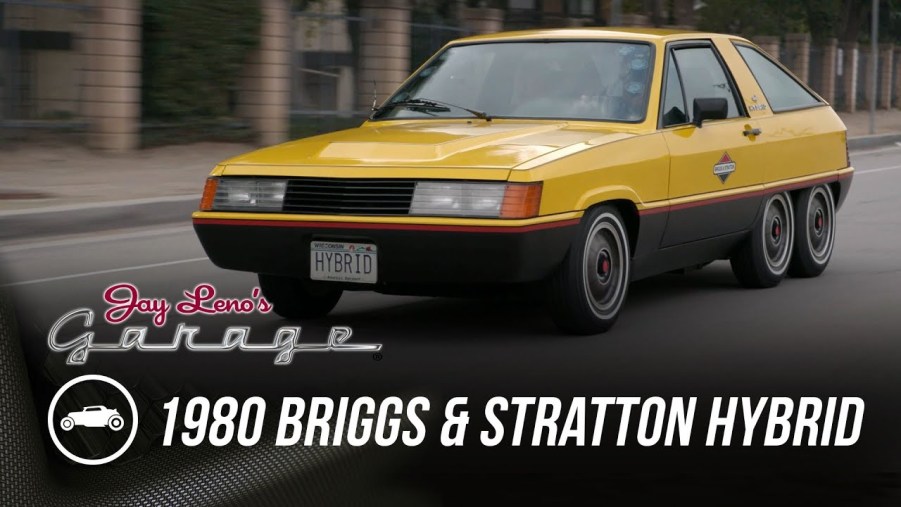
Jay Leno Drives the 6-Wheel Briggs & Stratton Hybrid: America’s Pre-Prius
Nowadays, hybrids are making up more and more of the average automaker’s production. Even SUVs like the Jeep Wrangler, Toyota Land Cruiser, and Range Rover are offering hybrid powertrains. Partially, this hybrid popularity is due to the Toyota Prius. But even before the Prius made it to the US, one American company had already developed a one-off hybrid. It’s the subject of Jay Leno’s latest video: the 1980 Briggs & Stratton Hybrid.
The story of the 1980 Briggs & Stratton hybrid
You might be more familiar with the Briggs & Stratton name than you think, Jalopnik reports. Today, the company is best known for making lawnmower, generator, and even kart-racing motors. Among their products are several twin-cylinder engines. And they’re not dissimilar from those found in classic bikes or classic cars like the Fiat 500 and Citroen 2CV. In fact, Silodrome reports Briggs & Stratton used to make motor-powered bicycles.
In 1980, the company debuted a then-new 18-hp two-cylinder. Briggs & Stratton wanted to show it off, but it was also wise to the gasoline crisis of the time. So, as Hemmings reports, engineers paired the fairly low-power engine with an 8-hp electric motor and roughly 1000 lbs of lead-acid batteries.
The Briggs & Stratton hybrid could run on either gasoline or electric power alone, or both together. To save costs, the concept was built from spare vehicle parts. The windshield and doors came from a Volkswagen Scirocco, and the platform a Canadian 6-wheeled delivery van. But only the middle wheels were driven, power going through a Ford Pinto 4-speed manual. However, there was a good reason for the extra axle, besides cost-savings.
Placing the lead-acid batteries on their own axle meant the weight was better-controlled. It also meant the batteries could be swapped out more easily, without even lifting the car.
However, unlike today’s high-performance hybrids, the Briggs & Stratton hybrid wasn’t exactly quick. The combined-mode top speed was about 68 mph, according to Car and Driver, and 0-60 was about 22 seconds. But it was efficient.
Using electricity to accelerate and gasoline to cruise, you could see up to 85 mpg. Though the electric-only range was only 30-60 miles. Even the Jeep electric mountain bike could probably do better.
How did Jay Leno like it?
Jay Leno was significantly more appreciative of the Briggs & Stratton hybrid’s build quality than he was of the $1.3-million Drako GTE. He also was impressed with some of the engineering choices, like using 12 6-volt batteries, rather than 6 12-volt ones, for more range. Although, Briggs & Stratton engineering technician Craig Claerbout points out you could replace the lead-acid batteries with two lithium-ion packs, each the size of a fantasy hardcover.
On the road, Jay found the Briggs & Stratton hybrid drives fairly well. There is road and wind noise, of course, which is expected given the late-70s-era design. Although the 1000-lb battery weight is noticeable, it doesn’t impact the ride or handling quite as much as it might if it was on a separate trailer.
During the ride, Jay Leno and Claerbout also discussed some of the early EVs and hybrids. Because, as it turns out, the Briggs & Stratton hybrid isn’t actually the first American hybrid.
Were there hybrids before this one?
In the early days of the automobile, gasoline wasn’t actually the only energy source available. Some of the first cars were powered by steam, and also batteries. In fact, Jay Leno owns one of the first electric cars ever made, the 1909 Baker Electric.
But, as Detroit’s Henry Ford Museum explains, gasoline eventually won out over electricity. It was cheaper, and refueling was a lot easier. Even so, electric car companies weren’t prepared to give up their business completely. So, as Hemmings reports, in 1916, Chicago’s Woods Motor Vehicles debuted the Woods Dual Power, the first American hybrid.

Woods claimed the Dual Power was 40% faster than a contemporary EV, but it didn’t have the complicated drivetrain a gasoline-powered car needed. It was also a parallel-hybrid, able to run on either the gasoline or electric motors alone. But, unlike the Briggs & Stratton, it could use the gasoline engine to recharge its batteries. It even had regenerative braking—in 1916. Unfortunately, the average worker would have to spend over 3 years’ wages to afford one, and in 1918, both the Dual Power and Woods itself fell by the wayside.

As forward-thinking as the Woods Dual Power was, it’s actually not the first hybrid. As Car and Driver reports, the first functional hybrid was built by Porsche founder Dr. Ferdinand Porsche in 1900. This was after developing purely-electric cars for several years. So, in a way, the Taycan EV is arguably the car that best represents Porsche’s heritage.
Follow more updates from MotorBiscuit on our Facebook page.


